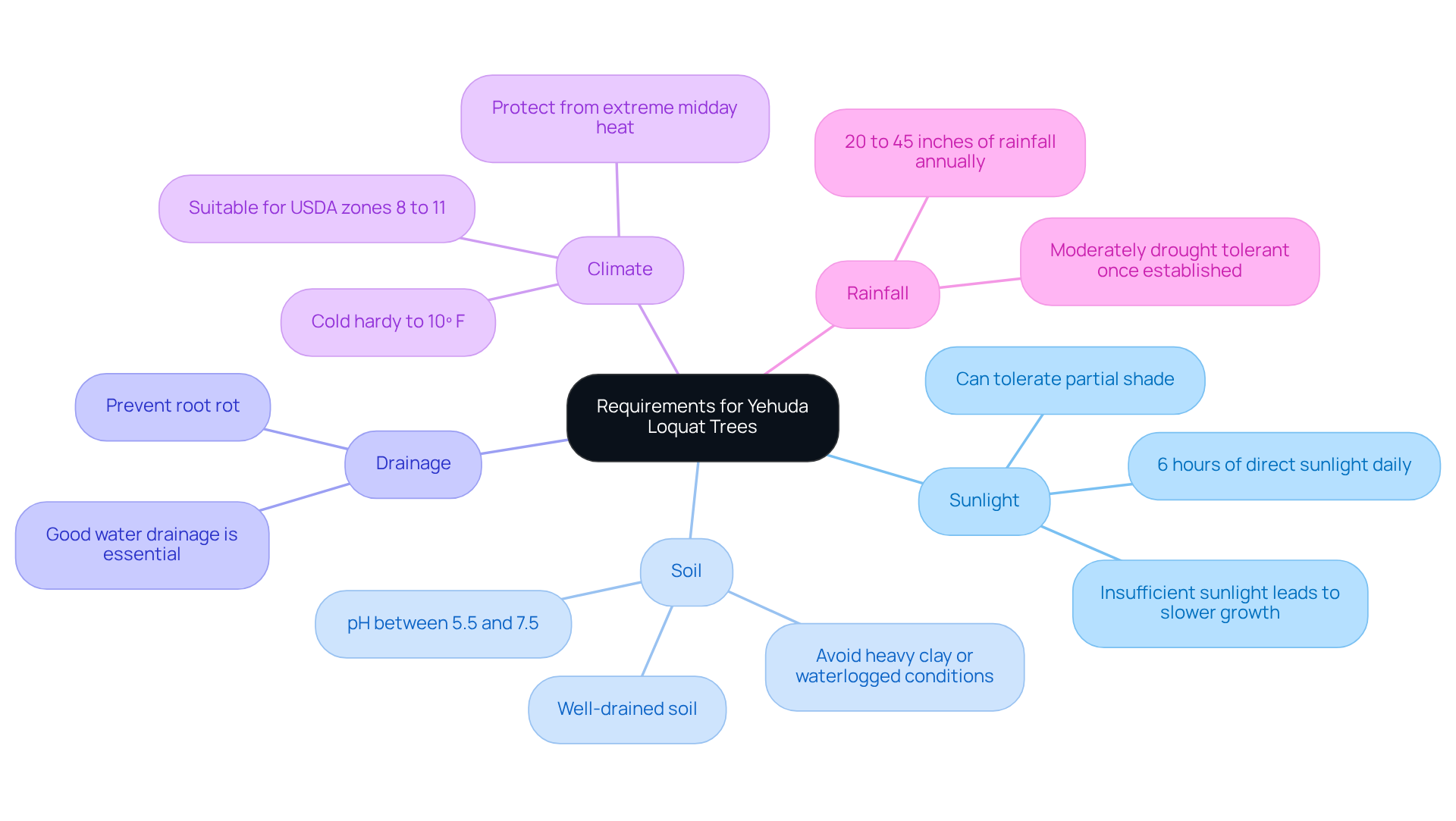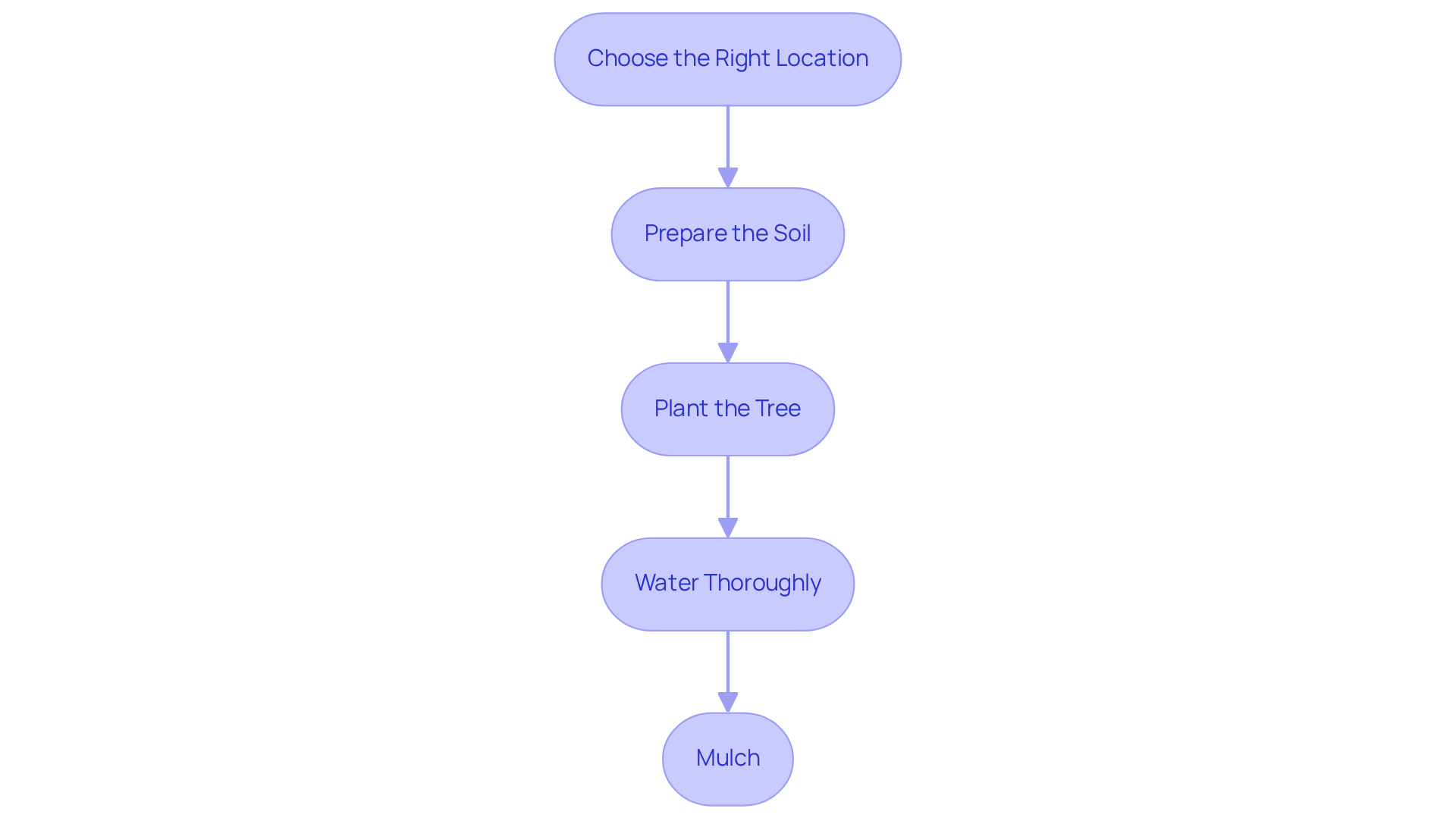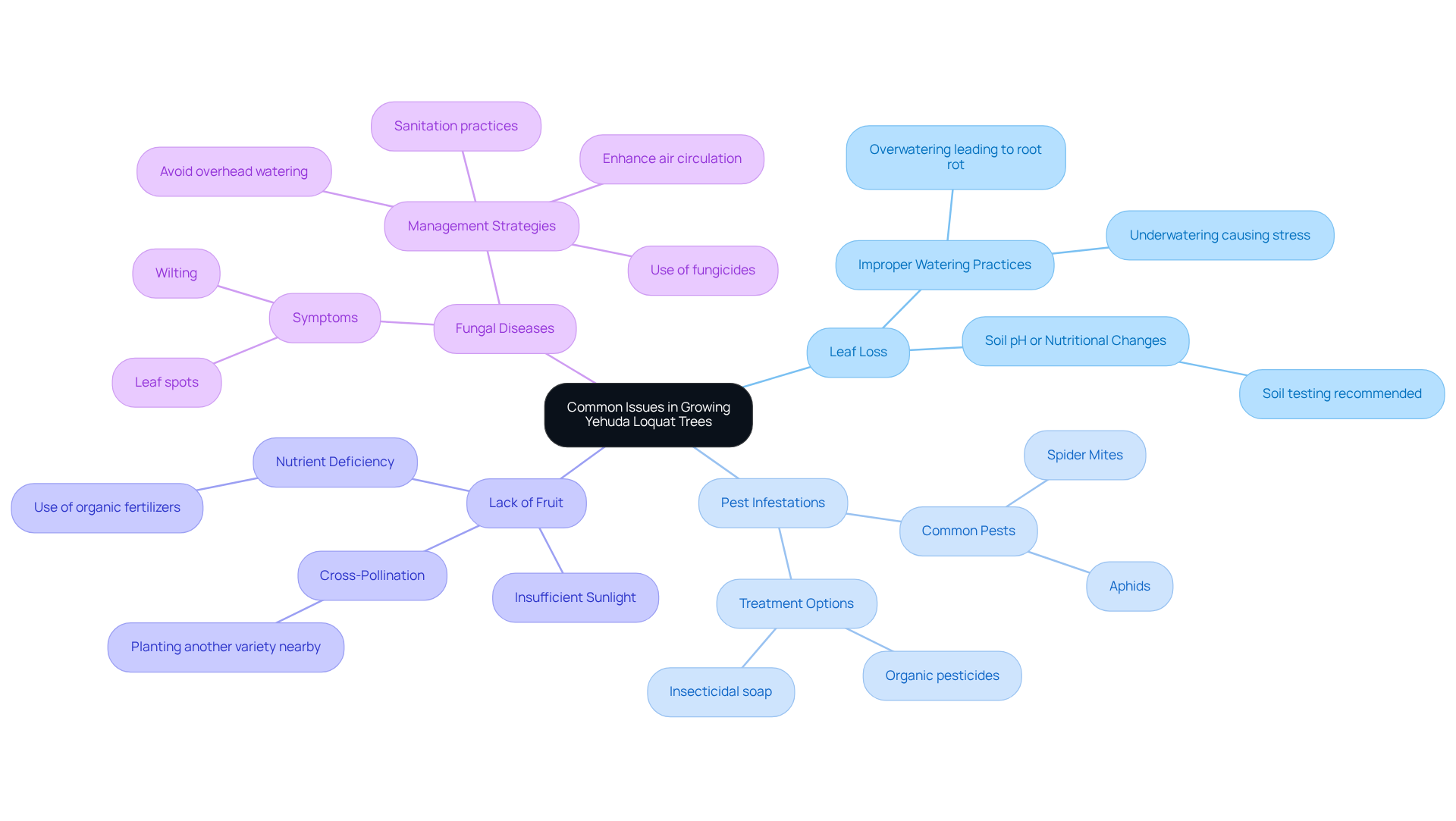The Yehuda loquat tree, characterized by its lush foliage and delectable fruit, offers an excellent opportunity for gardeners aiming to enrich their outdoor spaces. By understanding the specific growth requirements and maintenance practices associated with this unique tree, one can cultivate a flourishing addition to any garden.
Nonetheless, many aspiring gardeners encounter challenges in ensuring optimal growth conditions and addressing common issues that may arise.
What strategies can be employed to successfully navigate these complexities and cultivate a thriving Yehuda loquat tree?
🥭 Thinking about growing a Yehuda Loquat Tree in your garden?
Explore the Yehuda Loquat Tree for sale at Everglades Farm - shipped directly from Florida.
1. Understand the Growing Requirements for Yehuda Loquat Trees
Yehuda loquat trees thrive in full sun and require at least daily. They prefer well-drained soil that is somewhat acidic to neutral, ideally with a pH between 5.5 and 7.5. It is crucial to avoid heavy clay or overly saturated soils, as these conditions can lead to root rot; thus, good water drainage is essential for their health. Additionally, these plants are resilient in USDA zones 8 to 11, making them suitable for subtropical and mild temperate climates. Loquat plants typically require local rainfall amounts of 20 to 45 inches annually to support optimal growth. Understanding these specific requirements will aid you in selecting the right planting site, ensuring the plant receives adequate light and drainage. As noted by horticulturists, "Loquats are one of our most popular options for homeowners seeking a rewarding and distinctive fruit plant for their yard." By considering these factors, you can facilitate robust growth for your yehuda loquat tree.

2. Plant the Yehuda Loquat Tree Correctly
To successfully plant your Yehuda Loquat tree, follow these essential steps:
- Choose the Right Location: Select a site that receives full sun exposure and has well-drained soil. It is crucial to avoid areas prone to stagnant water, as this can hinder the growth of the plant.
- Prepare the Soil: Dig a hole that is three times the diameter of the root ball and equal in depth. Loosening the soil at the bottom of the hole is vital for promoting healthy root development.
- Plant the Tree: Position the tree in the hole, ensuring that the top of the root ball is level with the surrounding soil. Refill the hole with soil, gently compressing it to eliminate air pockets that could impede establishment.
- Water Thoroughly: After planting, provide a to help settle the soil around the roots. This initial hydration is critical for the establishment and future growth of the plant.
- Mulch: Apply a layer of mulch around the base of the plant to retain moisture and suppress weed growth, keeping it about inches away from the trunk to prevent rot.
As gardening experts remind us, "The best moment to plant a sapling was 20 years ago; the second best moment is now," highlighting the importance of taking timely action in nurturing your garden.

3. Maintain and Care for Your Yehuda Loquat Tree
To ensure your Yehuda Loquat tree thrives, it is essential to adhere to the following maintenance practices:
- Watering: Consistent watering is crucial, particularly during dry spells. Newly planted saplings should receive water every 2-3 days for the initial few weeks. After this period, reduce the frequency to once a week, allowing the soil to dry slightly between waterings. This practice promotes healthy root development, which is vital for the tree's growth.
- Fertilization: In early spring, apply a balanced fertilizer specifically formulated for fruit trees. This will support strong development and enhance fruit production. Following the manufacturer's guidelines for application rates is important to avoid over-fertilization, which can hinder growth and negatively affect the tree's health.
- Pruning: Conduct annual pruning in late winter to eliminate dead or crossing branches and to shape the plant effectively. This practice enhances air circulation and light penetration, both of which are vital for optimal fruit production and overall tree vitality.
- Pest Control: Regularly examine your plant for common pests such as aphids and scale insects. Utilize , such as insecticidal soap or neem oil, as necessary to preserve the health of your plant. By monitoring and managing pests, you can ensure a flourishing tree.
By adhering to these guidelines, you can nurture a thriving Yehuda Loquat tree that produces delicious fruit while enhancing the vibrancy of your garden.
4. Troubleshoot Common Issues in Growing Yehuda Loquat Trees
Common issues you may encounter with your Yehuda Loquat tree include:
- If your yehuda loquat tree is losing leaves, it may be due to improper watering practices. Overwatering can lead to root rot, while underwatering can stress the tree. Frequently monitor the ground moisture and modify your watering timetable to maintain steady moisture levels. Consider getting your soil tested through the UMaine Soil Analytical Lab in the spring, as changes in pH or nutrition can also cause defoliation.
- Pest Infestations: Keep an eye out for pests like aphids and spider mites, which can significantly affect your plant's health. Early detection is crucial; treat infestations promptly using organic pesticides or insecticidal soap to minimize damage and promote recovery. Notably, 39% of homeowners reported seeing rodents in their garages, which can also affect garden health indirectly.
- If your yehuda loquat tree is not yielding fruit, it may not be receiving adequate sunlight or nutrients. Ensure it is planted in a location that receives full sun and consider enriching the soil with organic fertilizers. Additionally, planting another variety nearby can enhance cross-pollination, improving fruit set.
- Fungal Diseases: Fungal infections can manifest as leaf spots or wilting. To tackle these problems, around the plant by trimming excess foliage and refrain from overhead watering, which can create a moist atmosphere favorable to fungal growth. Jonathan Foster highlights that sanitation methods, including appropriate pruning and quickly clearing debris, are crucial in controlling fungal diseases, as they often survive in detritus close to the plants. If necessary, apply a fungicide specifically labeled for use on fruit trees to manage severe infections.

Conclusion
Mastering the growth of the Yehuda loquat tree necessitates a comprehensive understanding of its specific needs and care practices. By ensuring that these trees receive the right conditions for sunlight, soil, and drainage, gardeners can create an environment conducive to robust growth and fruitful harvests. Employing proper planting techniques, maintaining consistent care, and addressing issues proactively are essential for fostering a healthy habitat for these unique fruit-bearing trees.
Key insights from this guide underscore the significance of:
- Selecting an optimal location
- Adequately preparing the soil
- Adhering to a diligent watering and fertilization schedule
Regular pruning and effective pest management further enhance the vitality of the Yehuda loquat tree. By promptly addressing common challenges such as leaf loss or pest infestations, gardeners can protect their trees and boost fruit production.
In summary, cultivating a thriving Yehuda loquat tree enriches a garden and offers a rewarding experience for those dedicated to its care. By embracing these best practices, gardeners can anticipate a fruitful yield and a vibrant addition to their landscape. With the right knowledge and commitment, anyone can enjoy the beauty and bounty of this remarkable tree.
Grow Your Own Tropical Paradise Today!
Start now with premium Yehuda loquat trees and unlock the secrets to a bountiful harvest.
Frequently Asked Questions
What are the sunlight requirements for Yehuda loquat trees?
Yehuda loquat trees thrive in full sun and require at least six hours of direct sunlight daily.
What type of soil is best for Yehuda loquat trees?
They prefer well-drained soil that is somewhat acidic to neutral, ideally with a pH between 5.5 and 7.5. Heavy clay or overly saturated soils should be avoided to prevent root rot.
In which USDA zones can Yehuda loquat trees grow?
Yehuda loquat trees are resilient in USDA zones 8 to 11, making them suitable for subtropical and mild temperate climates.
How much rainfall do Yehuda loquat trees need annually?
Loquat plants typically require local rainfall amounts of 20 to 45 inches annually to support optimal growth.
Why is it important to understand the requirements of Yehuda loquat trees?
Understanding these specific requirements will aid in selecting the right planting site, ensuring the plant receives adequate light and drainage for robust growth.





0 comments